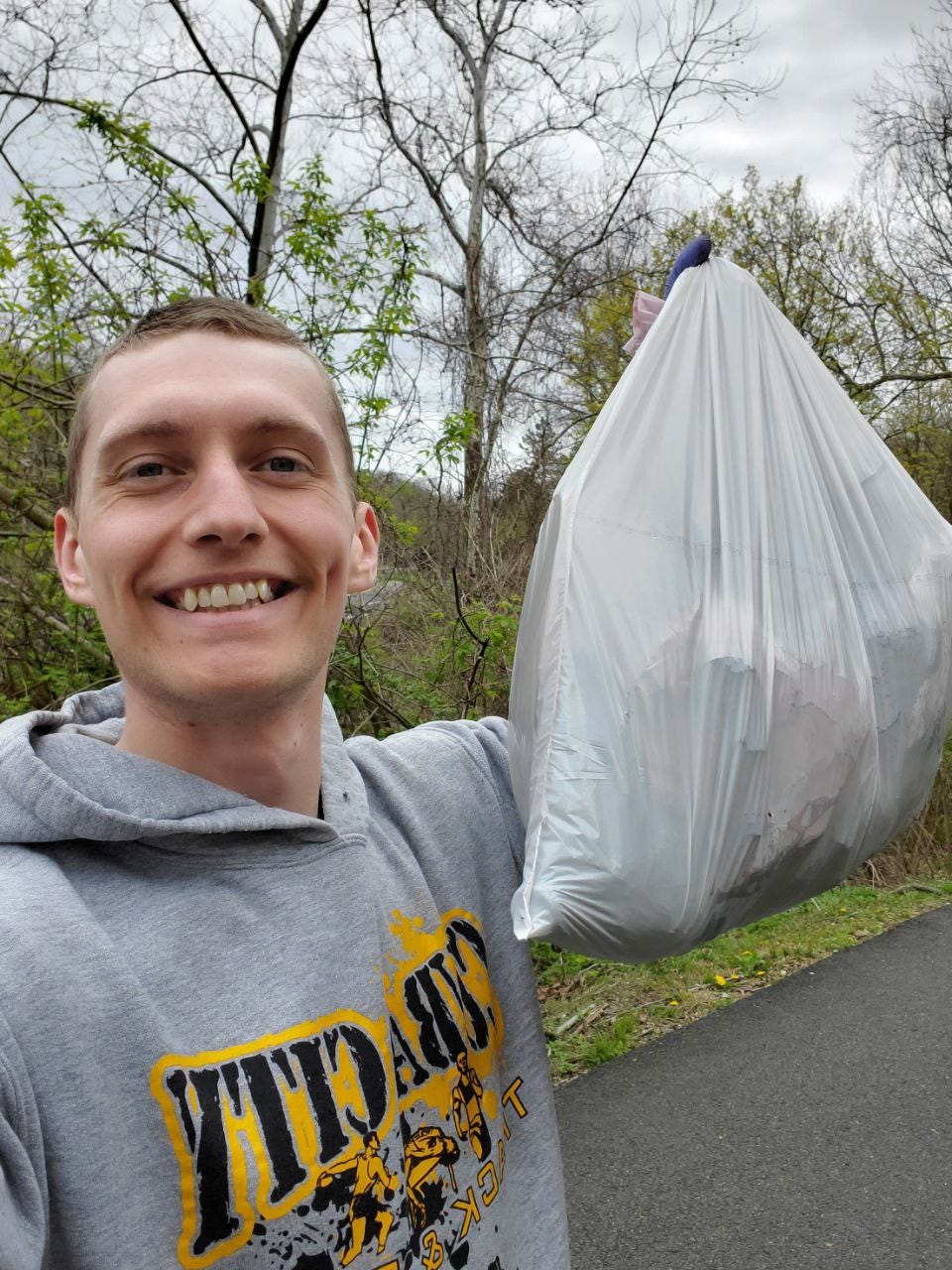To the Stars with Data: April 24 2022
Carbon dioxide removal takes center stage, the electric vehicle transition, no more anti-satellite tests, and much more
Hello Datanauts!
Did you know that mason bees hatching from their cocoons sounds like soft crackling and popping?
“But Joe, how do you know this?”, you may ask.
Our bees hatched today! The experience was truly magical. Man, I love nature.
Anyways, because it was Earth Day on Friday, I dive into things humans are doing to reverse climate change. I even snuck in a picture of me fighting pollution at the bottom of this issue. I hope that you leave feeling inspired!
Now, let’s go to the stars with data!
Thought-Provoking Data Viz

⚡ The US electric vehicle (EV) transition in 5 charts
Quick hits. If we can ever hope for electric vehicles (EVs) to be the dominant vehicle type on the market, we must look at what powers them: batteries. Luckily, these 5 charts do just that. Here’s a quick summary (note, this article unfortunately only addresses the US):
The projected number of EVs on the road will approach 27 million by 2030
The cost of lithium-ion battery packs, the best mass-market battery we have at the moment, is approaching $157/kWh in 2021, down from ~$1,250 in 2008.
By 2030, we will have a huge deficit of lithium (1,750,000 metric tons) due to high demand. (Note, this assumes that we continue using lithium-ion batteries.)
The range of EVs continues to grow, with the median range being 259 miles in 2020. This is still ~63% of the 400-425 mile median of gas-powered cars.
As we use more batteries, more and more batteries reach their end-of-life each year. At current estimates, the number will approach 1 million batteries each year by 2030. Luckily, the materials in EV batteries can be recycled.
Digging deeper. The adoption of EVs at the scale needed to address the climate crisis presents many problems that we’ll need to address in the coming years. As noted in this article, one of the problems is the batteries: not only do we need to make a lot of them (which requires many materials), but we also need to make them better to increase the driving range and cheaper to increase adoption. Another problem is the availability of EV chargers. In many countries, vehicle infrastructure is built to support gas-powered vehicles, not electrically-powered vehicles. Altogether, this means that it may take 30+ years for half or more of vehicles on the road to be electric in the US. Interested in learning more? I recommend The Long Road to Electric Cars, a viz I shared last month.
Earth News

💨 The increasing effort to scale carbon dioxide removal technologies
What is CDR? Carbon dioxide removal (CDR) is exactly what it sounds like: the removal of carbon dioxide from our atmosphere. This can be done through technology (like direct air capture, “DAC”) or even biological processes (like planting a ton of trees). Though the idea of CDR (and DAC in particular) have generally been ramping up over the past several years, updates within the past few weeks have substantially increased the pace at which humanity is seizing the opportunity.
What happened? Over the past month, an unprecedented billions of dollars have been invested in CDR:
First, Stripe and a large number of other companies created Frontier, an advanced market commitment for CDR technologies. The advanced market commitment ensures that the growing CDR industry will have demand for its products, ensuring it can scale at the appropriate level for the climate crisis. According to Frontier’s website, they also plan to open up to new buyers after a while to increase demand even further.
Second, legislators in the US introduced legislation to provide federal support for CDR tech. Similar legislation is going through multiple states as well (including my home state, New York!).
Third, Climeworks receives a $650 million (!!!!) funding round. Though its technology is nascent (its current plant only pulls 4,000 tonnes of CO2 out of the atmosphere each year), the investment is needed to get the technology to remove 1 million tons annually by 2030.
Finally, Lowercarbon Capital also announced $350m in funding for backing carbon-removal startups.
Why is CDR important? The most recent report from the Intergovernmental Panel on Climate Change (IPCC) is clear: to remain at or below 1.5 degrees of global warming, we must remove carbon dioxide from the atmosphere… on the order of billions of tons. (Considering that 1.5 degrees still entails a lot of horrible consequences, I think we should listen to the experts.) Let’s put this in perspective: 1 wild yak weighs approximately 1 ton. This means that we need to remove billions of wild yaks out of the sky. And soon.
Do you think we can do it? I’m feeling hopeful.
Other Earth news
💬 Using a new training method, DeepMind has created a new language AI that significantly outperforms much larger AIs. The article gets quite technical, but it’s a good read about the optimal training methodology for language AIs!
🦌 Scientists analyze wildlife images with AI to aid animal conservation. In some cases, the AI outperforms humans because we can’t see outside of the visible color spectrum or have trouble recognizing individual animals based on their features (e.g. number and position of spots).
🔋 Researchers accidentally discover potential breakthrough in battery tech. The breakthrough could lead to lithium-sulfur batteries, which are much easier to produce and last far longer than lithium-ion batteries. Don’t expect to see these batteries on shelves soon; research can take a while to translate to commercial products. But this gives me a lot of hope for our current battery crisis.
Space News
💥 The US promises not to conduct Anti-satellite (ASAT) missile testing in space
Quick hits. The US announced this week that it will not conduct anti-satellite (ASAT) missile testing in space, becoming the first country to make such a promise. In hopes of establishing this practice as a norm, they are calling on other nations to make this commitment as well. The announcement is the first of other anticipated announcements coming from the US Space Priorities Framework, where the US aims to expand national security architecture and peaceful norms in space.
Digging deeper. If you’ve been a long-time subscriber, you know that I don’t much care for space debris, which is a direct consequence of anti-satellite missiles. If even one satellite is blown by an anti-satellite missile, we could have potentially tens of thousands of new pieces of space debris in orbit, each going tens of thousands of miles/kilometers per hour. This, naturally, drastically increases the possibility of further collisions, each of which distribute even more debris. There’s even a name for this horrific chain reaction: Kessler Syndrome.
Other space news
🌏 Researchers make the case for Low-Earth Orbit (LEO) to be considered an additional Earth ecosystem (like the ocean or atmosphere). Right now, LEO is falling prey to the Tragedy of the Commons, where humans are exploiting it for their own interests and not considering others. Considering it its own ecosystem will allow for it to become legally protected.
📡 All antennas at the Very Large Array are now ready to stream data for technosignature research. (Technosignatures are technological signatures left by other civilizations that indicate their presence. An example for us would be light pollution.) Now, researchers searching for extraterristrial intelligence (SETI) will be able to see the terabytes of data in real-time. The first mission, starting in early 2023, will be a survey of around 40 star systems in our galaxy.
🦾 NASA developed a new metal alloy that is 1,000 times stronger than existing state-of-the-art alloys. The researchers created it by using AI to help design the structure and 3D printing to obtain the optimal shape and distribution of material. Compared to other state-of-the-art alloys, this alloy has twice the strength to resist fracturing, 3.5x the flexibility to stretch/bend prior to fracturing, and 1,000+ times the durability under stress at high temperatures.
Future-Thinking Companies
🌊 Vyld
Vyld, based in Berlin, makes period products out of seaweed. Many period products right now are manufactured from plastics, which means they are bad for the environment and our bodies. However, when farmed in environmentally friendly ways, seaweed is much better for the environment and allows for products that biodegrade.
🚀 Green Launch
Green Launch launches payloads into space with, basically, a giant cannon (the technical term is “hydrogen impulse launcher”, which is much less fun). Launching payloads using this method significantly reduces the amount of energy and materials needed, which makes it much more environmentally friendly when compared to traditional rockets. In Dec 2021, they demonstrated firing a payload into the stratosphere at Mach 3 using a 54-foot-long launcher (as seen in the above video).





